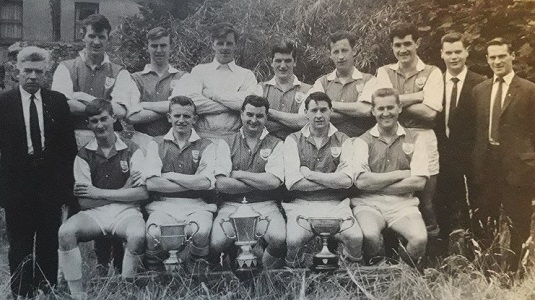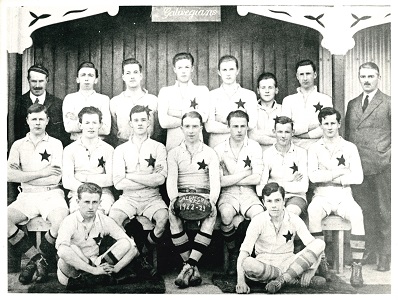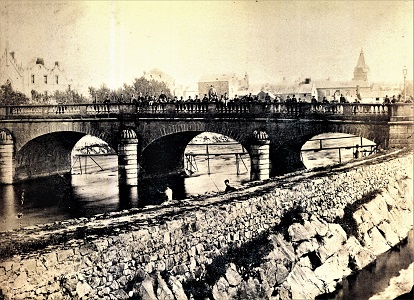Old Galway
WILFRID SCAWEN BLUNT IN GALWAY GAOL

by Tom Kenny
Blunt was an aristocratic English writer, a person of remarkable ability who, as “the best looking man in England was credited with having refreshed the blood of several ancient families”. He was always against colonialism and sympathetic to small nations, so it was no surprise that he became an ardent supporter of Home Rule for Ireland. In 1887, he was in Ireland to study the grievances of the people when he heard that evictions had recommenced on the 56,000-acre estate of Lord Clanricarde in Woodford.
John Dillon and William O’Brien, both MPs had already attended a protest meeting in Woodford on October 17th, 1886, with 4,000 other people. They drew up a ‘Plan of Campaign’ to seek ‘a reasonable and fair reduction in rents due’. Clanricarde’s agent was ‘determined to resort to every measure that might be necessary to enforce his claims and would expend whatever funds were necessary for the purpose’. A year later, O’Brien decided to organise another meeting on the estate and invited Blunt to attend. The meeting was proscribed but they held it anyway, at midnight on bitterly cold night. O’Brien publically burned a copy of the Lord Lieutenant’s proclamation with Blunt standing by his side.
SANTA CLAUS COMES TO GALWAY

by Tom Kenny
St. Nicholas of Myra is the patron saint of archers, sailors, merchants, repentant thieves, brewers, pawnbrokers, unmarried people, students and of children. He is also the patron saint of Galway, and our oldest church, St. Nicholas Collegiate is named after him. He was a legendary giver of gifts, particularly to the poor. He would hand coins in through windows or open doors, and if they were closed, sometimes he would put them down the chimney. This was the origin of the tradition of Santa coming down the chimney bearing gifts. The tradition was good for business for chimney sweeps, it would be difficult to explain soot marks on the floor on Christmas morning.
JOHN KEADY, A TRIBUTE

by Tom Kenny
Now that we are reaching the end of saturation coverage of the World Cup and watching some of the best soccer players in the world, you might wonder where it all began for some of them, how they got themselves on to the world stage, and how much they owe to the unsung people without whom they would never have succeeded, the referees whose dedication to the game make all of those matches possible.
One such referee in Galway is John Keady from Bohermore who has given a lifetime to the game. As a youth, he played soccer with the Galway Hibernians team who won the under-15 Galway League in 1955. They beat Boys Club 3 – 2 in the final, Pete Reilly scoring all the goals for them. Our first photograph shows that team, they are, front row, left to right; Eddie Conneely, John Keady, Brian Delargy, Bernie Cooley, Ted Fitzpatrick, Michael Keady. Back row; Mick Killeen, Peter O’Connor, Brod King, P.J. Connolly and Mixie Glynn.
LIAM MELLOWS, ENIGMATIC REPUBLICAN & NOTORIOUS IRRECONCILABLE

by Tom Kenny
William Mellows was born in Ashton-under-Lyne, Manchester, where his father, Staff Sergeant William Mellows was then stationed. His father had ambitions for the son to become the fourth generation of the family to serve in the armed forces, but after they moved back to Ireland, Liam became steadily disillusioned with the British Government. He lived in Dublin for a time and spent a lot of time living in his grandparents’ house in Co. Wexford, where his mother came from.
He was described as a ‘pale, shy, studious little boy’ and he started work as a clerk in D’Olier Street in Dublin at the age of thirteen. His nationalism slowly began to surface, he started calling himself Liam and was regularly reading Bulmer Hobson’s paper Irish Freedom. His father had expected him to join the British Army, and must have been very upset when Liam told him if he was going to fight, it would be for Ireland and on Irish soil. Liam’s brother Barney was of a similar opinion, but eventually their father managed to get over his disappointment and in fact had a very close relationship with his two sons thereafter.
THE GALWAY STARVATION RIOTS

by Tom Kenny
Our illustration today was published in the Illustrated London News on June 25th, 1842, and was intended to “Convey an idea of the desperation to which the poor people of Galway have been reduced by the present calamitous season of starvation. The scene represented above is an attack upon a potato store in the town of Galway, on the 13th of the present month, when the distress had become too great for the poor squalid and unpitied inhabitants to endure their misery any longer, without some more substantial alleviation than prospects of coming harvest; and their resource in this case was to break open the potato stores and distribute their contents, without much discrimination, among the plunderers, and to attack the mills where oatmeal was known to be stored”.
GALWEGIANS R.F.C., 100 YEARS

by Tom Kenny
It is fairly certain that rugby football was being played in Galway before the formation of the IRFU but the lack of surviving minutes of meetings or records makes it difficult to pinpoint the actual beginnings of some clubs. We know that in 1886, there were four clubs in existence, Queen’s College (now UG), The Grammar School, Galway Town and Old Galwegians. These latter two clubs amalgamated in the 1909/10 season and called themselves Galway Town. They were a successful club. The First World War and its aftermath ruled out competitive rugby but in the resumption in 1921/22 they again won the senior cup and then, for some reason, decided to change the name again, this time to Galwegians RFC.
THE SALMON WEIR BRIDGE

by Tom Kenny
The Foundation stone for this bridge was laid on June 29th, 1818, by William Le Poer Trench and the structure was completed the following year. The original purpose was to connect the new County Courthouse with the County Gaol on Nun’s Island. It is a fine gently humped five-span bridge which was originally known as ‘The New Bridge’ or ‘Gaol Bridge’.
The major public works scheme begun during the Famine which constructed the canal, steamer’s Quay, and built up the banks on each side of the river, resulted in excavations of the depth of the river which necessitated the underpinning of the piers and abutments of the bridge to an extent of 7 feet. This was completed with ashlar masonry of a character which was suitable to that of the bridge.
Just above the bridge was the weir which backed up the water above it to afford power for some dozen mills through the 19th century.
THE GALWAY SHAWL

by Tom Kenny
The Galway Shawl was a specific type of heavyweight shawl worn by women during the cold season. It was very popular during the 19th century and was still being worn by a few older more traditional women up until the 1950s. It was worn by women all over Ireland, but for some reason, was known as the Galway Shawl. It was a winter-weight outer garment and was worn over a lightweight one.
The Galway Shawl was woven on a hand jacquared loom in Paisley, Scotland, but used neither the design nor the construction of the Paisley shawl. The Galway version was woven on a cotton warp with a weft of botany wool. These reversible shawls were a solid colour in the centre with a decorative multi-coloured wide border and they were fringed. The solid colour was often fawn and the border design was usually in browns and reds. They contained neither velvet nor fur but were referred to as such because they were heavily milled in the finishing and a soft velvet-like nap was raised on the surface. In 1892, one Paisley company employed 40 weavers making these shawls. The garments were sent to the Galway Woollen Mills where the fringes were applied.
